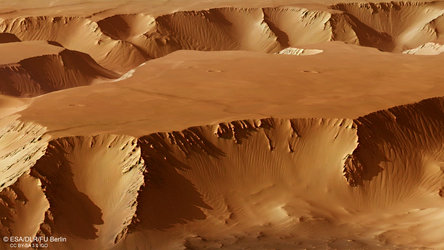Accept all cookies Accept only essential cookies See our Cookie Notice

About ESA
The European Space Agency (ESA) is Europe’s gateway to space. Its mission is to shape the development of Europe’s space capability and ensure that investment in space continues to deliver benefits to the citizens of Europe and the world.
Highlights
ESA - United space in Europe
This is ESA ESA facts Member States & Cooperating States Funding Director General Top management For Member State Delegations European vision European Space Policy ESA & EU Space Councils Responsibility & Sustainability Annual Report Calendar of meetings Corporate newsEstablishments & sites
ESA Headquarters ESA ESTEC ESA ESOC ESA ESRIN ESA EAC ESA ESAC Europe's Spaceport ESA ESEC ESA ECSAT Brussels Office Washington OfficeWorking with ESA
Business with ESA ESA Commercialisation Gateway Law at ESA Careers Cyber resilience at ESA IT at ESA Newsroom Partnerships Merchandising Licence Education Open Space Innovation Platform Integrity and Reporting Administrative Tribunal Health and SafetyMore about ESA
History ESA Historical Archives Exhibitions Publications Art & Culture ESA Merchandise Kids Diversity ESA Brand Centre ESA ChampionsLatest
Space in Member States
Find out more about space activities in our 23 Member States, and understand how ESA works together with their national agencies, institutions and organisations.
Science & Exploration
Exploring our Solar System and unlocking the secrets of the Universe
Go to topicAstronauts
Missions
Juice Euclid Webb Solar Orbiter BepiColombo Gaia ExoMars Cheops Exoplanet missions More missionsActivities
International Space Station Orion service module Gateway Concordia Caves & Pangaea BenefitsLatest
Space Safety
Protecting life and infrastructure on Earth and in orbit
Go to topicAsteroids
Asteroids and Planetary Defence Asteroid danger explained Flyeye telescope: asteroid detection Hera mission: asteroid deflection Near-Earth Object Coordination CentreSpace junk
About space debris Space debris by the numbers Space Environment Report In space refuelling, refurbishing and removingSafety from space
Clean Space ecodesign Zero Debris Technologies Space for Earth Supporting Sustainable DevelopmentApplications
Using space to benefit citizens and meet future challenges on Earth
Go to topicObserving the Earth
Observing the Earth Future EO Copernicus Meteorology Space for our climate Satellite missionsCommercialisation
ESA Commercialisation Gateway Open Space Innovation Platform Business Incubation ESA Space SolutionsLatest
Enabling & Support
Making space accessible and developing the technologies for the future
Go to topicBuilding missions
Space Engineering and Technology Test centre Laboratories Concurrent Design Facility Preparing for the future Shaping the Future Discovery and Preparation Advanced Concepts TeamSpace transportation
Space Transportation Ariane Vega Space Rider Future space transportation Boost! Europe's Spaceport Launches from Europe's Spaceport from 2012Latest

Noctis Labyrinthus stereo pair
Thank you for liking
You have already liked this page, you can only like it once!
ExoMars was launched on a Proton-M rocket from Baikonur, Kazakhstan on 14 March 2016. Around seven months later, it arrived at Mars.
As part of preparations for its main science mission to analyse the atmosphere for gases that may be related to biological or geological activity, and image sites that might be related to these sources, the Trace Gas Orbiter has conducted two campaigns to test its science instruments – one last November and one last week.
Presented here is one of the first image pairs taken by the orbiter’s high-resolution camera on 22 November.
The images together form a stereo pair of part of the Noctis Labyrinthus region of Mars. The camera takes one image looking slightly forwards (bottom image in this orientation), and then, after having flown over the area, it rotates to look ‘back’ to take the second part of the image (top), in order to see the same region of the surface from two different angles.
By combining the image pair, a 3D image can be constructed and information about the relative heights of the surface features can be seen.
The images were taken to test the timing of the images as the spacecraft moves over the surface, in order to best reconstruct the stereo images. Additional tests were conducted last week to fine-tune the process.
Noctis Labyrinthus, or ‘Labyrinth of the night’, lies on the western edge of Valles Marineris, the grand canyon of the Solar System, and comprises a vast network of flat-topped plateaus and trenches. Landslides are seen in the flanks of the steep slopes.
Since arriving, the orbiter has also conducted a number of manoeuvres to change its orbital period and inclination, ready to begin the year-long aerobraking phase later this week. This process will use the planet’s atmosphere to gradually slow the spacecraft speed and so move it into a 400 km near-circular orbit, from which the craft will conduct its main science mission.
The images were taken by the CaSSIS camera; the scale here is 7.2 m/pixel and the images correspond to an area on Mars about 15 x 45 km.
-
CREDIT
ESA/Roscosmos/CaSSIS -
LICENCE
CC BY-SA 3.0 IGO or ESA Standard Licence
(content can be used under either licence)

Noctis Labyrinthus stereo pair (b)

Noctis Labyrinthus stereo pair (a)

Noctis Labyrinthus context

3D view in Noctis Labyrinthus















 Germany
Germany
 Austria
Austria
 Belgium
Belgium
 Denmark
Denmark
 Spain
Spain
 Estonia
Estonia
 Finland
Finland
 France
France
 Greece
Greece
 Hungary
Hungary
 Ireland
Ireland
 Italy
Italy
 Luxembourg
Luxembourg
 Norway
Norway
 The Netherlands
The Netherlands
 Poland
Poland
 Portugal
Portugal
 Czechia
Czechia
 Romania
Romania
 United Kingdom
United Kingdom
 Slovenia
Slovenia
 Sweden
Sweden
 Switzerland
Switzerland

























